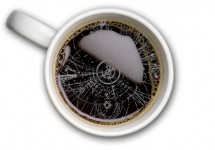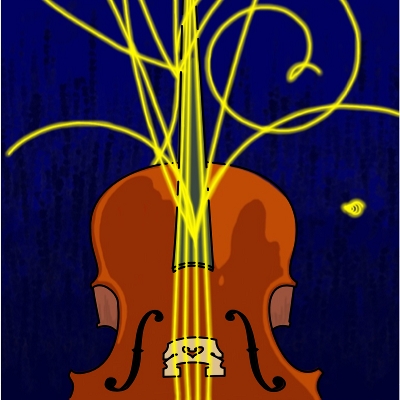

Paszenko the Cat is a music critic. I don’t say that just because he looks for a better place to nap whenever I play my cello— I wouldn’t blame any creature for that. It’s because he seeks out good music. He sits attentively, ears forward, whenever the music is harmonious and full of pentatonic intervals. But he has no patience for anything as modern as a diminished fifth.
My cat made his tastes obvious one day when a tutor came to give me cello lessons. The cellos came out of their boxes and Paszenko casually left the room. But when my teacher began to play, he came back. He got closer, sniffed the strange cello, and hopped into the teacher’s lap while he was still playing. And purred.
What colors a sound most is the path that it takes to get into our ears. From cello string to bridge to chamber to cat’s body sounds different than it would if it had bounced around the room before reaching Paszenko’s eardrums. As the waves flow from one object to another, they excite resonances whose frequencies depend on the shapes of those objects— the fancy curves in a cello’s body are not merely decorative. Remote as it may seem, the creation and destruction of subatomic particles works the same way. This is more than an analogy: it is one of the ways nature repeats herself at vastly different scales.
Sound is a vibration in a material such as string, wood, or air. High-pitched sounds are rapid oscillations, while low-pitched sounds are slow. Most sounds involve two or more frequencies at the same time: imagine a low note and a high note played simultaneously— it sounds different from a single note in the middle with the average frequency. A wave with two frequencies looks like a rapid wiggle on top of a leisurely undulation, and our ears can identify both parts. In fact, our ears have receptors to distinguish 15–20 thousand different frequencies at the same time: we usually hear them as complex textures.
The richness of a cello’s voice is due to the many overlapping frequencies it produces at once, even when the cellist only intends to play one note. The peculiarities of the cello’s shape enhances some frequencies and suppresses others as the waves propagate from the string through the bridge into its big wooden bubble. The plot below shows the spectrum of a cello playing a G# note: the tall peaks are frequencies that resonate loudly (large amplitude), and the gaps between them are relatively silent.

Cello spectrum from an analysis on Vobarian Software (©2009 Chad Berchek).
Keep in mind that all of these frequencies are active when the cello is playing only one note. This pattern is not what makes a G# sound different from a G, but what makes a cello sound different from an oboe. The two sound clips below demonstrate what this spectrum does: one is played by a cello (not me) and the other is synthesized with pure tones. Both have melody and dynamics, but the pure-tones version plays exactly one frequency at a time. It is what a cello would sound like without its characteristic spectrum.
Subatomic particles such as electrons and quarks are vibrations in a mathematical abstraction called a field. A field is a set of numbers at every point in space, and a vibration in the field is when the numbers increase and decrease rapidly, like the height of water in a rippling pond, but without the pond. Energetic particles are rapid oscillations of the field, while lethargic particles are slow oscillations, much like high-pitched and low-pitched sounds.
There is a field for every type of particle: an electron field for electrons and positrons (positrons are the antimatter version of electrons), a quark field for each of the different kinds of quarks, a photon field for light, and many others. Not only can waves flow from one place to another— that’s how particles move— but waves can flow from one field into another— that’s how old particles disintegrate and new particles are born.
Here’s how subatomic particles resemble sound: a sound wave that propagates into the resonant body of the cello and, from there, into the air and our ears is much like an electron wave that flows into the photon field (becomes light) and then flows into a quark field (becomes quarks). The phenomena are so similar that physicists use the same terminology and mathematical tools for both— they only differ in the details.

Relevant parts of a cello.
To be specific, let’s consider an activity that has become common among physicists: accelerating particles to high speeds and smashing them together. If they are equal and opposite particles, like an electron and an positron, then their energy can flow into any other equal and opposite: a quark and an antiquark, a muon and an antimuon, or even a neutrino and an antineutrino. The degree to which energy flows into each of these fields depends on how well it is “coupled” to the electron field. This coupling is another abstraction— a number, nothing to visualize. However, it’s a lot like coupling in acoustics. On a cello, the degree to which energy flows from a vibrating string into the wooden body depends on how tightly they are coupled by the bridge. In our universe, the electron field is much more tightly coupled to the quark field than it is to the neutrino field, so electron-positron collisions are more likely to result in quarks than neutrinos. The entirety of particle physics is to learn what fields exist and understand why they have the couplings that they do.
To be even more specific, suppose we collide an electron and a positron with 15 GeV of energy. That’s a lot of energy, but not an enormous amount. How much flows into the quark fields? The plot below shows the result: it is the quark spectrum that is excited by a 15 GeV electron-positron (e+e−) collision, in exact analogy with the cello spectrum above. The tall peaks indicate frequencies that resonate loudly, and the gaps between them are relatively silent.

Quark spectrum, computed from experimental data provided by the Particle Data Group.
This could be thought of as the sound of an electron and a positron colliding. The particles are too small to cause air molecules to vibrate— what we normally call sound. But if we’re interested in the characteristic frequencies that the collisions produce, we could think of the vibrations of the quark fields as something like a sound. This sound is universal: the same spectrum is produced by electrons and positrons colliding in a basement accelerator as in the atmosphere of a neutron star, thousands of light years away. Just as the mellow tone of a cello derives from its peculiar size and shape, the spectrum of the quark field, when plucked with 15 GeV, has something to do with the field’s geometry.
Let’s listen to that spectrum. It is way too high-pitched for human hearing, so I transposed it down 74 octaves. Here is what it sounds like for one electron to collide with one positron:
The interference of waves with slightly different frequencies causes some sounds to be short-lived while others linger. Listen a few times to hear how the initial ping differs from the sustained ringing. Or instead listen to the clip below, which is the sound of 10,000 e+e− pairs colliding over the course of a few seconds— this extends the short-lived part in a realistic way (laboratory experiments rarely collide just one pair of particles).
It sounds pure, like bells or windchimes, because the quark spectrum has far fewer resonances than a cello. The rain-like tapping of low-pitched, short-lived sounds is due to the rho resonance. Rho is made of quarks like the ones in ordinary protons, but it is so unsturdy that it falls apart in a millionth of a billionth of a billionth of a second. The mid-range jingle is known as charm— its simplicity and straight-forward interpretation convinced a generation of scientists that quarks are real, not just a convenient fiction in calculations. The faint, high-pitched hum at the end is called beauty. I think it sounds like a gong that has stopped ringing, but is still tremulous to the touch.